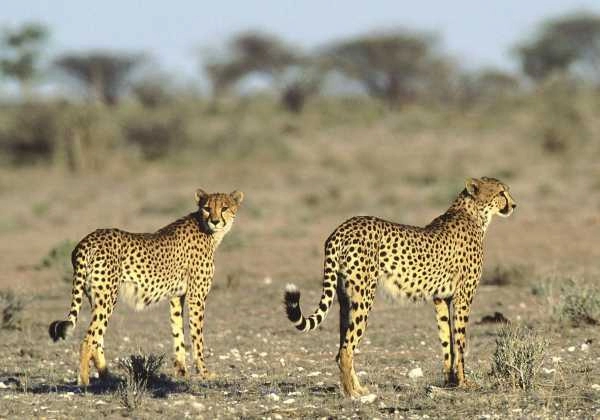Namibia attractions - The Etosha National Park is a vast expanse of game-rich savannah centred on an immense saltpan - the Etosha Pan. This makes it ideal for photographic safaris.

Etosha National Park is home to four of the Big 5. Visitors to Etosha Game Reserve can expect to see many buck species, elephant, giraffe, rhino and lions. More fortunate visitors will see leopard and cheetah. There is a network of roads linking the five camps and subsidiary roads lead to various waterholes.
Etosha National Park is located nearly 500km (311 miles) north of Namibia’s capital, Windhoek.
Etosha National Park is located nearly 500km (311 miles) north of Namibia’s capital, Windhoek.
Centred around the vast expanse of the Etosha Pan, the park is a sanctuary to the largest population of the western sub-species of the black rhino, white rhino, large herds of elephant, the striking black-faced impala, lions and a profusion of other animals and birds. The Etosha Pan covers about 25% of the park.
It was the largest game reserve in the world until the 1960s when, for political reasons, it was reduced by three-quarters. This was to form a tribal resettlement scheme by the South African apartheid government. The Etosha National Park is now approximately 22 275km2.
Etosha is Namibia’s premier wildlife destination – game viewing along the numerous springs and waterholes often reveals lion, leopard, elephant, southern giraffe, red hartebeest, rare black-faced impala, endangered black rhino, as well as more common plains game such as blue wildebeest, Burchell’s zebra, desert-adapted gemsbok and springbok in their hundreds. The comical ground squirrels, with their bushy parasol-like tails, are also a highlight.
Bird-life in Etosha is prolific with over 340 species recorded - including several of Namibia’s 14 endemics. Sociable weavers and their enormous communal nests, pugnacious pygmy falcons and the brilliantly coloured crimson-breasted shrike are common highlights. Namaqua sandgrouse, double-banded courser, northern black korhaan and many lark species (spike-heeled, pink-billed, sabota and Stark’s) occupy the plains. The acacia thickets harbour yellow-bellied eremomela, pririt batis and Acacia pied barbet. Birds like red-headed finch and lark-like bunting also commonly flock around waterholes where predatory red-necked falcon often look for a meal.
Etosha Pan is a giant (about 5000km2) clay salt pan forming a shallow depression which allows amazing views of the game. For most of the year it is a silvery-white shimmer of baked mud with perennial springs along the edge. These are rich in mineral salts and attract a variety of birds and animals. If a lot of rain is experienced, the whole pan fills with water, leading to spectacular game viewing and bird watching.
The best time to visit Etosha National Park is from May to September/October - the cooler & dryer months (winter) in Namibia when many of the animals are concentrated at waterholes (due to lack of rainfall) and the grass is low thus allowing for better game viewing.
The pan is often completely dry at this time making the landscape ideal for photography. This is the busiest time in the park for visitors so you will need to book well in advance.
From November to April (rainy season), the days get very hot (up to 40 degrees celcius) and Etosha transforms from a dry, dusty white landscape to a lush green paradise. Birdlife is amazing with birds migrating south to Etosha - the pan turns into a lake which attracts wetland birds and flamingos.
Elephants and other larger mammals head north where less rainfall is experienced.
Book your This email address is being protected from spambots. You need JavaScript enabled to view it. now.
The pan is often completely dry at this time making the landscape ideal for photography. This is the busiest time in the park for visitors so you will need to book well in advance.
From November to April (rainy season), the days get very hot (up to 40 degrees celcius) and Etosha transforms from a dry, dusty white landscape to a lush green paradise. Birdlife is amazing with birds migrating south to Etosha - the pan turns into a lake which attracts wetland birds and flamingos.
Elephants and other larger mammals head north where less rainfall is experienced.
Book your This email address is being protected from spambots. You need JavaScript enabled to view it. now.
